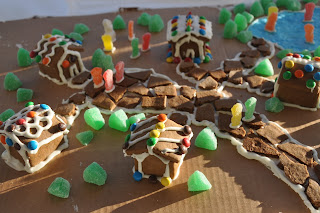I forgot to take pictures! I took a quick photo the night I finished making them, but I completely forgot to take any nice photos or photos of the graham crackers! Duh. Now the crackers are gone, for they were tasty.
Here is my one photo:

Recipe follows. I did not use cream in the middle layer; I used evaporated milk. I used slivered almonds and about half the sugar called for in the base (I heard they were very sweet, and seeing as they were to be covered in buttercream, I was not going there).
I have to say, I was skeptical, but I really liked these. I would make the graham crackers again, and I would make nainamo bars again. I would not, however, make graham crackers just to crush up for the nainamo bars. They will be great for s'mores this summer though!
The original recipe for the graham crackers here: http://www.101cookbooks.com/archives/000126.html, but subbed 1/2 whole wheat and 1/2 unbleached wheat flour. I've put my modifications below.
Graham Cracker Recipe:
2 1/2 cups plus 2 tablespoons, half unbleached wheat flour and half whole wheat pastry flour.
1 cup dark brown sugar, lightly packed
1 teaspoon baking soda
3/4 teaspoon salt
7 tablespoons (3 1/2 ounces) unsalted butter, cut into 1-inch cubes and frozen
1/3 cup mild-flavored honey, such as clover
5 tablespoons whole milk
2 tablespoons pure vanilla extract
For the topping:
3 tablespoons granulated sugar
1 teaspoon ground cinnamon
In the bowl of a food processor fitted with the steel blade or in the bowl of an electric mixer fitted with the paddle attachment, combine the flour, brown sugar, baking soda, and salt. Pulse or mix on low to incorporate. Add the butter and pulse on and off on and off, or mix on low, until the mixture is the consistency of a coarse meal.
In a small bowl, whisk together the honey, milk, and vanilla extract. Add to the flour mixture and pulse on and off a few times or mix on low until the dough barely comes together. It will be very soft and sticky.
Turn the dough out onto a lightly floured work surface and pat the dough into a rectangle about 1 inch thick. Wrap in plastic and chill until firm, about 2 hours or overnight.
To prepare the topping: In a small bowl, combine the sugar and cinnamon, and set aside.
Divide the dough in half and return one half to the refrigerator. Sift an even layer of flour onto a silpat on a cookie sheet and roll out to about 1/8 inch thickness. The dough will be sticky, so flour as necessary. Gather the scraps together and set aside. Sprinkle crackers with the topping.
Bake at 350 for 12 minutes as you do the other half of the dough, then bake that, too.
Adjust the oven rack to the upper and lower positions and preheat the oven to 350 degrees.
Gather the scraps together into a ball, chill until firm, and reroll. Bake them.
Nanaimo Bars
Ingredients:
For Nanaimo Bars — Bottom Layer
1/2 cup (115 g) (4 ounces) Unsalted Butter
1/4 cup (50 g) (1.8 ounces) Granulated Sugar --- I used 1/2 this amount, and they balanced out the middle layer quite well for my family's/friend's tastes.
5 tablespoons (75 mL) Unsweetened Cocoa
1 Large Egg, Beaten
1 1/4 cups (300 mL) (160 g) (5.6 ounces) Graham Wafer Crumbs
1/2 cup (55 g) (1.9 ounces) Almonds (I used slivered)
1 cup (130 g) (4.5 ounces) Coconut (I used sweetened)
For Nanaimo Bars — Middle Layer
1/2 cup (115 g) (4 ounces) Unsalted Butter
2 tablespoons and 2 teaspoons (40 mL) Heavy Cream (I used evaporated milk)
2 tablespoons (30 mL) Vanilla Custard Powder (Such as Bird’s. Vanilla pudding mix may be substituted.)
2 cups (254 g) (8.9 ounces) Icing Sugar
For Nanaimo Bars — Top Layer
4 ounces (115 g) Semi-sweet chocolate
2 tablespoons (28 g) (1 ounce) Unsalted Butter
Directions:
1. For bottom Layer: Melt unsalted butter, sugar and cocoa in top of a double boiler. Add egg and stir to cook and thicken. Remove from heat. Stir in crumbs, nuts and coconut. Press firmly into an ungreased 8 by 8 inch pan.
2. For Middle Layer: Cream butter, cream, custard powder, and icing sugar together well. Beat until light in colour. Spread over bottom layer.
3. For Top Layer: Melt chocolate and unsalted butter over low heat. Cool. Once cool, pour over middle layer and chill.



















